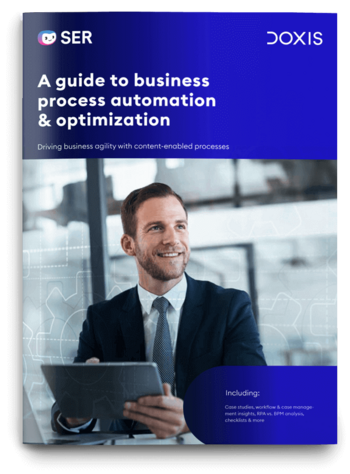SER Blog Innovation & Technology
Digital process re-engineering: Rethinking the relationship with content
When organizations embark on digital process transformation, it’s typically with a view to overhauling operational cost-efficiency, performance and compliance; improving and personalising experiences for employees and customers; and enabling ongoing adaptation and optimization of processes over time. But success in any of these areas relies on the ability to more seamlessly integrate processes and supporting content.*

It is a strategic imperative now that organizations review and can hone and even reinvent their business processes in line with the way the market is moving, and with the soaring expectations of customers. Unless they can adapt the way they operate, they will struggle to stay relevant.
Beyond the need to keep improving the customer experience, there will be other external market influences which add to the pressure to stay nimble and able to flex with demand. Over the last year, these have included the impact of the pandemic on supply/demand and buyer behavior. Disruptive forces are never far away, either. Somewhere, right now, a rival could be setting a higher bar for more streamlined transactions or service delivery, raising market expectations.
A case in point: insurance claims-handling
When it comes to information and processes, companies must evolve from operating a system of records - a classic document management system - to creating a system of understanding if they are to keep pace with change.
Take the processes involved in insurance claims handling. This is both a resource-intensive activity, and one that needs to be managed efficiently to ensure a positive customer experience, at what could be a very stressful and anxious time for the customer (if there has been an accident, break-in, or problem on holiday).
Insurance claims-handling is also the kind of activity that service providers would love to automate, if they could find a way to more seamlessly sort routine from more complex claims, enabling them to treat each case in the most effective and efficient way, while also empowering customers to do more for themselves, where possible - allowing them to feel more in control of their claim’s progress. All of which relies on teams or automated capabilities being able to call in and manage content more seamlessly as part of the flow of work.
As long as users have to switch between different IT systems and screens to inform their next action, the scope for bold new process efficiencies and for better experiences will be restricted. Being able to manage business processes and supporting content together via the same platform would enable teams to innovate in a range of ways. This might involve using content sentiment analysis to help prioritize responses to angry or anxious customers, for instance; or providing facilities for clients to upload their own claims forms, photos and other evidence to accelerate processing.
Given that the teams currently handling claims workloads will have a strong grasp of relative case complexity, who the subject experts are, and how those people’s time is best spent, it follows that these users are the ideal people to adapt and hone case management processes.
It’s this kind of adaptive scenario businesses should be aiming for – rather than one in which they try to specify the ultimate new process up front, and build this rigidly into everyday operations for the next five years (during which time needs will undoubtedly change, and new service options will come to the fore.)
The ideal is to stay flexible, providing strong but malleable parameters that the business can adapt as needed, because there will always be new room for improvement.

Intelligent claims management in car insurance
This video demonstrates how claims handling and fraud detection are supported by smart processes and LOB integrations to ensure fast, transparent, error-free and efficient claims management.
Watch nowA case in point: Enterprise contract compliance
Consider the scope for transforming current approaches to contract management. A more integrated and intelligent approach to managing processes and content makes it possible both to tighten and streamline compliance, security and information governance, and to manage contracts and supplier relationships in a smarter and more strategic way (by linking contracts to supplier records, timelines and cost/value analytics, to inform process automation/contact prioritisation/business planning).
Banks and financial services providers also recognize the potential to combine agreements with their own customizable intelligence to manage new and enhanced regulations around the retention and management of data - requirements which might otherwise tie up teams for months. Using intelligent content analytics and extraction would allow financial organizations to perform automated analysis of their loan agreements, for instance, storing a set of metadata for each one - as stipulated by regulators.
More fluid links between processes & content
Laying the foundations for next-generation business process management must start with a platform that can link processes and relevant content and deliver them to the right person, in the right context, at the right time so that they can complete tasks promptly, confidently and efficiently.
Where legacy investments are holding back transformation, consider a solution that preserves the value of existing document management repositories, ERP or CRM systems via direct integration, so that the rich information captured in these systems can be put to extended business use.
Content federation (using virtual/external information objects to create a 360° view of diverse information stored across legacy back-office systems) and intelligent information management provide a path forward here, allowing content from other line-of-business applications to be brought into play. It could even provide an initial step to eventual system consolidation, keeping the business’s options open.
Whichever way businesses look at it, a bold new future demands a fresh and more holistic approach to process transformation in which documents, content and data are much more seamlessly integrated at the point of need.

Business process automation & optimization guide
How can you digitize, automate & streamline your business processes for greater agility, customer experience & operational efficiency? Our in-depth guide provides actionable recommendations, case studies & checklists to help you achieve process digitalization.
Read now*This article originally appeared in Document Manager on April 1, 2021

Dr. Gregor Joeris
In addition to his role as a Managing Director of SER Group Holding International GmbH, Dr. Gregor Joeris is also the innovative mind behind SER's technologies & products. Gregor studied Computer Science at RWTH Aachen University and received his PhD in Bremen, Germany. As the Chief Technology Officer and a Managing Director of SER Software Technology GmbH, Gregor is responsible for the design and further development of SER's flagship product Doxis.
The latest digitization trends, laws and guidelines, and helpful tips straight to your inbox: Subscribe to our newsletter.
How can we help you?
+49 (0) 30 498582-0Your message has reached us!
We appreciate your interest and will get back to you shortly.




